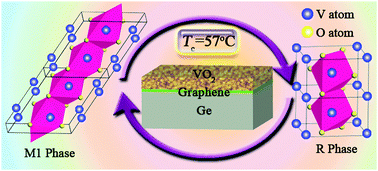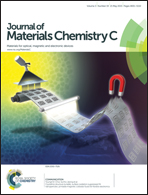Electron transfer induced thermochromism in a VO2–graphene–Ge heterostructure
Abstract
As a marvelous thermochromic material, vanadium dioxide (VO2) holds great promise for applications in smart devices due to its semiconductor–metal transition (SMT), which is an active response to external temperature stimuli and near-infrared irradiation. Herein, we demonstrate for the first time that the phase transition temperature of a VO2 film can be effectively manipulated using graphene as an interlayer. A high quality graphene monolayer was deposited using chemical vapor deposition on a Ge underlayer, followed by the growth of a VO2 film onto the graphene to form a semimetal–semiconductor contact, namely, a VO2–graphene–Ge junction. The thermochromic properties of the VO2 film were demonstrated with ∼20% infrared reflectance contrast. Furthermore, the transition temperature of the VO2 film was effectively reduced from 340 K to 330 K. On the basis of the Mott–Hubbard phase transition theory, a plausible mechanism is proposed here for the first time from the perspective of charge transfer to elucidate the experimental phenomenon, which indicates that the electron transfer can increase the electron concentration in the VO2 film and destabilize the semiconductor phase of the VO2 film, thus decreasing the SMT temperature of the thermochromic VO2 film. In addition to stimulating scientific interest, this study may also contribute to thermochromic VO2-based applications in sensors, optical and electrical switches, and other nanodevices.


 Please wait while we load your content...
Please wait while we load your content...